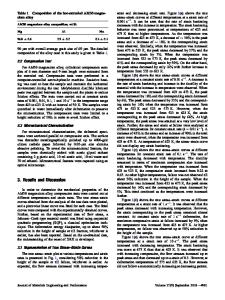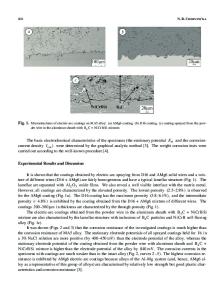Evaluation of the Athermal Effect of Electric Pulsing on the Recovery Behavior of Magnesium Alloy
- PDF / 1,260,267 Bytes
- 6 Pages / 593.972 x 792 pts Page_size
- 82 Downloads / 310 Views
DUCTION
OWING to the current emphasis on fuel efficiency and environmental impact, weight reduction represents an important issue in the automotive industry. The high specific strength and low density of magnesium alloys make these materials potential alternatives to the steel and aluminum alloys, commonly used in the industry. The application of magnesium alloys has, however, so far been limited by their poor formability at low temperature, which originates from their insufficient slip system activation and particular texture.[1-4] Therefore, magnesium alloys are usually formed at temperatures higher than 523 K (250 °C) in order to increase their ductility by activating non-basal slip systems, which inevitably leads to problems in terms of process cost, surface quality, and dimensional accuracy. Electrically assisted forming (EAF) was recently introduced as an alternative metal-forming technique that is capable of enhancing the formability of a metal and reducing springback after deformation by applying electricity to a metal blank.[5-12] However, it is still unclear whether the effects of the electric current on the mechanical behavior can be attributed exclusively to Joule heating. According to some studies, the enhancement in mechanical behavior achieved by EAF could also be related to athermal effects created through an increased dislocation mobility resulting from SE-JONG KIM, SUNG-DAE KIM, and JINWOO LEE, Senior Researchers, DONGHOON YOO, Researcher, and YOUNGMOK RHYIM, Principal Researcher, are with the Korea Institute of Material Science, 66 Sangnam-dong, Changwon-si, Gyeongnam 641831, Republic of Korea. Contact e-mail: [email protected] DAEYONG KIM, Principal Researcher, is with the Korea Institute of Material Science and also with the Korea University of Science and Technology, 217 Gajeongro, Daejeon 305-350, Republic of Korea. Contact e-mail: [email protected] Manuscript submitted June 20, 2016. Article published online October 20, 2016 6368—VOLUME 47A, DECEMBER 2016
interactions between electrons and the elastic field of dislocations,[13] dislocation depinning caused by the current-induced magnetic field,[14] additional momentum transferred via electron wind,[15] and compressive stress created by the current-induced intrinsic magnetic field.[16] Other investigations, on the other hand, have suggested that Joule heating is the sole origin of the electric current’ effect on the mechanical behavior of metal.[10,17] In the present study, we assessed the athermal effects of electric pulses (EP) on the recovery behavior of a pre-tensioned magnesium alloy by comparing the mechanical behavior, dislocation density, and hardness of pre-tensioned specimens subjected to EP and conventional heat treatment using an oil bath. The dislocation behavior under EP was observed by in situ transmission electron microscopy (TEM).
II.
EXPERIMENTAL PROCEDURES
A commercial AZ31 magnesium alloy sheet of 1.4 mm thickness was used in this study. The material was machined into tensile specimens with a 6 mm gage width and 15 mm gage length a
Data Loading...











